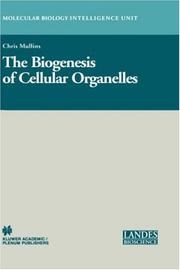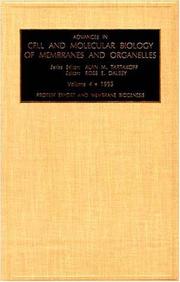| Listing 1 - 10 of 100 | << page >> |
Sort by
|
Periodical
Abstract | Keywords | Export | Availability | Bookmark
 Loading...
Loading...Choose an application
- Reference Manager
- EndNote
- RefWorks (Direct export to RefWorks)
Pathology, Experimental --- Pathology, Experimental. --- Pathologie expérimentale. --- Pathologic Processes. --- Pathology. --- Organelle Biogenesis. --- Mitochondrial Biogenesis --- Biogeneses, Organelle --- Biogenesis, Mitochondrial --- Biogenesis, Organelle --- Organelle Biogeneses --- Pathological Processes --- Processes, Pathologic --- Processes, Pathological --- Experimental pathology --- Pathologies --- Disease --- pathology --- Pathology --- Pathologic Processes --- Biogenesis --- Biogenesis. --- Evolution, Chemical --- Pathologie expérimentale --- Origin of Life --- Genesis of Life --- Life Geneses --- Life Genesis --- Life Origin --- Life Origins --- Organelle Biogenesis
Book
Abstract | Keywords | Export | Availability | Bookmark
 Loading...
Loading...Choose an application
- Reference Manager
- EndNote
- RefWorks (Direct export to RefWorks)
The nucleolus is a prominent nuclear domain that is common to eukaryotes. Since the nucleolus was first described in the 1830s, its identity had remained a mystery for longer than 100 years. Major advances in understanding of the nucleolus were achieved through electron microscopic and biochemical studies in the 1960s to 1970s followed by molecular biological studies. These studies finally established the view of the nucleolus that it is a large aggregate of RNA-protein complexes associated with the rRNA gene region of chromosome DNA, serving mainly as a site of ribosome biogenesis, where pre-rRNA transcription, pre-rRNA processing, and ribosome assembly occur. This function of the nucleolus appears to indicate that the nucleolus plays a constitutive and essential role in fundamental cellular activities by producing ribosomes. Recent research has shown, however, that the nucleolus is more dynamic and can have more specific and wider functions. In plants, nucleolar functions have been implicated in developmental regulations and environmental responses by accumulating pieces of evidence obtained mostly from genetic studies of nucleolar factor-related mutants. Comprehensive analysis of nucleolar proteins and molecular cytological characterization of sub-nucleolar and peri-nucelolar bodies have also provided new insights into behaviors and functions of the plant nucleolus.
In this Research Topic, we would like to collect physiological and molecular links between the nucleolus to plant growth and development, shed light on novel aspects of nucleolar functions beyond its classical view, and stimulate research activities focusing on the nucleolus across various fields of plant science, including molecular biology, cell biology, genetics, developmental biology, physiology, and evolutionary biology.environmental response --- development --- plant --- nucleolus --- growth --- ribosome biogenesis
Book
Abstract | Keywords | Export | Availability | Bookmark
 Loading...
Loading...Choose an application
- Reference Manager
- EndNote
- RefWorks (Direct export to RefWorks)
The peroxisome is an organelle with essential roles in lipid metabolism, maintenance of reactive oxygen species homeostasis, and anaplerotic replenishment of tricarboxylic acid cycle intermediates destined for mitochondria. Peroxisomes constitute a dynamic endomembrane system. The homeostatic state of this system is upheld via two pathways for assembling and maintaining the diverse peroxisomal compartments constituting it; the relative contribution of each pathway to preserving such system may vary in different organisms and under various physiological conditions. One pathway begins with the targeting of certain peroxisomal membrane proteins to an endoplasmic reticulum template and their exit from the template via pre-peroxisomal carriers; these carriers mature into metabolically active peroxisomes containing the entire complement of membrane and matrix proteins. Another pathway operates via growth and maturation of pre-existing peroxisomal precursors that do not originate from the endoplasmic reticulum; mature peroxisomes proliferate by undergoing fission. Recent studies have uncovered new roles for the peroxisomal endomembrane system in orchestrating important developmental decisions and defining organismal longevity. This Frontiers Special Topic Issue is focused on the advances in our understanding of how evolutionarily distant organisms coordinate the formation, maturation, proliferation, maintenance, inheritance and quality control of the peroxisomal endomembrane system and how peroxisomal endomembranes communicate with other cellular compartments to orchestrate complex biological processes and various developmental programs from inside the cell.
peroxisomal endomembrane system --- development --- Reactive Oxygen Species --- Aging --- peroxisome --- Lipid Metabolism --- Endoplasmic Reticulum --- peroxisome biogenesis

ISBN: 1417574488 1280804211 9786610804214 0387268677 0306479907 144193426X Year: 2005 Publisher: Georgetown, TX : New York, N.Y. : Landes Bioscience/Eurekah.com ; Kluwer Academic/Plenum,
Abstract | Keywords | Export | Availability | Bookmark
 Loading...
Loading...Choose an application
- Reference Manager
- EndNote
- RefWorks (Direct export to RefWorks)
The Biogenesis of Cellular Organelles represents a comprehensive summary of recent advances in the study of the biogenesis and functional dynamics of the major organelles operating in the eukaryotic cell. This book begins by placing the study of organelle biogenesis in a historical perspective by describing past scientific strategies, theories, and findings and relating these foundations to current investigations. Reviews of protein and lipid mediators important for organelle biogenesis are then presented, and are followed by summaries focused on the endoplasmic reticulum, Golgi, lysosome, nucleus, mitochondria, and peroxisome. .
Cell organelles --- Cytoplasm. --- Formation. --- Cells --- Protoplasm --- Assembly of cell organelles --- Biogenesis of cell organelles --- Formation of cell organelles --- Origin of cell organelles --- Assembly --- Biogenesis --- Origin --- Growth --- Immunology. --- Immunobiology --- Life sciences --- Serology

ISBN: 1281060208 9786611060206 0080526098 1559389249 9781559389242 9780080526096 Year: 1995 Publisher: Greenwich, CT : JAI Press,
Abstract | Keywords | Export | Availability | Bookmark
 Loading...
Loading...Choose an application
- Reference Manager
- EndNote
- RefWorks (Direct export to RefWorks)
The incentive for putting together Volume 4 of this series was to review the wealth of new information that has become available in prokaryotic organisms in protein export and membrane biogenesis. Just in the last several years, protein translocation has now been efficiently reconstituted using defined components and the mechanism by which proteins are moved across membrane bilayers is now being examined at a higher resolution. In addition, because of a new technical breakthrough using osmolytes, it is now possible to reconstitute a number of channel proteins, ATPase, receptors, and transporte
Cell membranes --- Membranes (Biology) --- Membrane proteins --- Formation. --- Fluidity. --- Physiological transport. --- Proteins --- Fluidity of biological membranes --- Membrane fluidity (Biology) --- Assembly of cell membranes --- Biogenesis of cell membranes --- Formation of cell membranes --- Origin of cell membranes --- Mechanical properties --- Assembly --- Biogenesis --- Origin
Book
Year: 2016 Publisher: Frontiers Media SA
Abstract | Keywords | Export | Availability | Bookmark
 Loading...
Loading...Choose an application
- Reference Manager
- EndNote
- RefWorks (Direct export to RefWorks)
One of the distinguishing features of plants is the presence of membrane-bound organelles called plastids. Starting from proplastids (undifferentiated plastids) they readily develop into specialised types, which are involved in a range of cellular functions such as photosynthesis, nitrogen assimilation, biosynthesis of sucrose, starch, chlorophyll, carotenoids, fatty acids, amino acids, and secondary metabolites as well as a number of metabolic reactions. The central role of plastids in many aspects of plant cell biology means an in-depth understanding is key for a holistic view of plant physiology. Despite the vast amount of research, the molecular details of many aspects of plastid biology remains limited. Plastids possess their own high-copy number genome known as the plastome. Manipulation of the plastid genome has been developed as an alternative way to developing transgenic plants for various biotechnological applications. High-copy number of the plastome, site-specific integration of transgenes through homologous recombination, and potential to express proteins at high levels (>70% of total soluble proteins has been reported in some cases) are some of the technologies being developed. Additionally, plastids are inherited maternally, providing a natural gene containment system, and do not follow Mendelian laws of inheritance, allowing each individual member of the progeny of a transplastomic line to uniformly express transgene(s). Both algal and higher plant chloroplast transformation has been demonstrated, and with the ability to be propagated either in bioreactors or in the field, both systems are well suited for scale up of production. The manipulation of chloroplast genes is also essential for many approaches that attempt to increase biomass accumulation or re-routing metabolic pathways for biofortification, food and fuel production. This includes metabolic engineering for lipid production, adapting the light harvesting apparatus to improve solar conversion efficiencies and engineering means of suppressing photorespiration in crop species, which range from the introduction of artificial carbon concentrating mechanisms, or those pre-existing elsewhere in nature, to bypassing ribulose bisphosphate carboxylase/oxygenase entirely. The purpose of this eBook is to provide a compilation of the latest research on various aspects of plastid biology including basic biology, biopharming, metabolic engineering, bio-fortification, stress physiology, and biofuel production.One of the distinguishing features of plants is the presence of membrane-bound organelles called plastids. Starting from proplastids (undifferentiated plastids) they readily develop into specialised types, which are involved in a range of cellular functions such as photosynthesis, nitrogen assimilation, biosynthesis of sucrose, starch, chlorophyll, carotenoids, fatty acids, amino acids, and secondary metabolites as well as a number of metabolic reactions. The central role of plastids in many aspects of plant cell biology means an in-depth understanding is key for a holistic view of plant physiology. Despite the vast amount of research, the molecular details of many aspects of plastid biology remains limited. Plastids possess their own high-copy number genome known as the plastome. Manipulation of the plastid genome has been developed as an alternative way to developing transgenic plants for various biotechnological applications. High-copy number of the plastome, site-specific integration of transgenes through homologous recombination, and potential to express proteins at high levels (>70% of total soluble proteins has been reported in some cases) are some of the technologies being developed. Additionally, plastids are inherited maternally, providing a natural gene containment system, and do not follow Mendelian laws of inheritance, allowing each individual member of the progeny of a transplastomic line to uniformly express transgene(s). Both algal and higher plant chloroplast transformation has been demonstrated, and with the ability to be propagated either in bioreactors or in the field, both systems are well suited for scale up of production. The manipulation of chloroplast genes is also essential for many approaches that attempt to increase biomass accumulation or re-routing metabolic pathways for biofortification, food and fuel production. This includes metabolic engineering for lipid production, adapting the light harvesting apparatus to improve solar conversion efficiencies and engineering means of suppressing photorespiration in crop species, which range from the introduction of artificial carbon concentrating mechanisms, or those pre-existing elsewhere in nature, to bypassing ribulose bisphosphate carboxylase/oxygenase entirely. The purpose of this eBook is to provide a compilation of the latest research on various aspects of plastid biology including basic biology, biopharming, metabolic engineering, bio-fortification, stress physiology, and biofuel production.
plastid transformation --- Metabolic Engineering --- plastid division --- Plastid development --- biopharming --- retrograde signalling --- plastid polymerases --- Plastid biogenesis --- Plastids --- Plastid replication
Book
Year: 2017 Publisher: Frontiers Media SA
Abstract | Keywords | Export | Availability | Bookmark
 Loading...
Loading...Choose an application
- Reference Manager
- EndNote
- RefWorks (Direct export to RefWorks)
Photosystem II is a 700-kDa membrane-protein super-complex responsible for the light-driven splitting of water in oxygenic photosynthesis. The photosystem is comprised of two 350-kDa complexes each made of 20 different polypeptides and over 80 co-factors. While there have been major advances in understanding the mature structure of this photosystem many key protein factors involved in the assembly of the complex do not appear in the holoenzyme. The mechanism for assembling this super-complex is a very active area of research with newly discovered assembly factors and subcomplexes requiring characterization. Additionally the ability to split water is inseparable from light-induced photodamage that arises from radicals and reactive O2 species generated by Photosystem II chemistry. Consequently, to sustain water splitting, a “self repair” cycle has evolved whereby damaged protein is removed and replaced so as to extend the working life of the complex. Understanding how the biogenesis and repair processes are coordinated is among several important questions that remain to be answered. Other questions include: how and when are the inorganic cofactors inserted during the assembly and repair processes and how are the subcomplexes protected from photodamage during assembly? Evidence has also been obtained for Photosystem II biogenesis centers in cyanobacteria but do these also exist in plants? Do the molecular mechanisms associated with Photosystem II assembly shed fresh light on the assembly of other major energy-transducing complexes such as Photosystem I or the cytochrome b6/f complex or indeed other respiratory complexes? The contributions to this Frontiers in Plant Science Research Topic are likely to reveal new details applicable to the assembly of a range of membrane-protein complexes, including aspects of self-assembly and solar energy conversion that may be applied to artificial photosynthetic systems. In addition, a deeper understanding of Photosystem II assembly — particularly in response to changing environmental conditions — will provide new knowledge underpinning photosynthetic yields which may contribute to improved food production and long-term food security.
Arabidopsis thaliana --- photoactivation --- photosynthesis --- Chlamydomonas reinhardtii --- cyanobacteria --- biogenesis --- Photosystem II --- photodamage --- Nicotiana tabacum --- Synechocystis sp. PCC 6803
Periodical
ISSN: 15730875 01696149 Year: 1968 Publisher: Springer Link Kluwer Academic Publishers,
Abstract | Keywords | Export | Availability | Bookmark
 Loading...
Loading...Choose an application
- Reference Manager
- EndNote
- RefWorks (Direct export to RefWorks)
Life --- Evolution --- Molecular biology --- Biosphere --- Biogenesis --- Molecular Biology --- Origin --- Organelle Biogenesis. --- Origin of Life. --- Biological Evolution. --- Vie --- Évolution --- Biologie moléculaire --- Biosphère --- Biosphere. --- Evolution. --- Molecular biology. --- Origines --- Périodiques. --- Origin. --- Molecular biochemistry --- Molecular biophysics --- Abiogenesis --- Germ theory --- Heterogenesis --- Life (Biology) --- Life, Origin of --- Origin of life --- Plasmogeny --- Plasmogony --- Philosophy --- Biochemistry --- Biophysics --- Biomolecules --- Systems biology --- Evolution (Biology) --- Exobiology --- Spontaneous generation --- Creation --- Emergence (Philosophy) --- Teleology --- Planets --- Gaia hypothesis --- Geobiology --- Genesis of Life --- Life Geneses --- Life Genesis --- Life Origin --- Life Origins --- Organelle Biogenesis --- Mitochondrial Biogenesis --- Biogeneses, Organelle --- Biogenesis, Mitochondrial --- Biogenesis, Organelle --- Organelle Biogeneses --- Evolution, Chemical --- Evolution, Biological --- Sociobiology --- Biological Evolution --- Origin of Life --- Évolution (Biologie) --- evolution. --- Periodicals. --- Animal evolution --- Animals --- Biological evolution --- Darwinism --- Evolutionary biology --- Evolutionary science --- Origin of species --- Biology --- Biological fitness --- Homoplasy --- Natural selection --- Phylogeny --- Prebiotic Chemical Evolution --- Chemical Evolution, Prebiotic --- Evolution, Prebiotic Chemical --- Prebiotic Chemical Evolutions

ISBN: 1281012270 9786611012274 1429483202 0080497616 012781910X Year: 2000 Publisher: San Diego, [California] : Academic Press,
Abstract | Keywords | Export | Availability | Bookmark
 Loading...
Loading...Choose an application
- Reference Manager
- EndNote
- RefWorks (Direct export to RefWorks)
Origins of Life on the Earth and in the Cosmos, Second Edition, suggests answers to the age-old questions of how life arose in the universe and how it might arise elsewhere. This thorough revision of a very successful text describes key events in the evolution of living systems, starting with the creation of an environment suitable for the origins of life. Whereas one may never be able to reconstruct the precise pathway that led to the origin of life on earth, one can certainly make some plausible reconstructions of it. Such discussions have greatly expanded our understanding of the pri
Life --- Origin. --- Abiogenesis --- Biogenesis --- Germ theory --- Heterogenesis --- Life, Origin of --- Life (Biology) --- Origin of life --- Plasmogeny --- Plasmogony --- Origin --- Evolution (Biology) --- Exobiology --- Spontaneous generation
Book
ISBN: 0262282097 1435694090 9780262282093 9781435694095 9780262182683 0262182688 Year: 2009 Publisher: Cambridge, Mass. MIT Press
Abstract | Keywords | Export | Availability | Bookmark
 Loading...
Loading...Choose an application
- Reference Manager
- EndNote
- RefWorks (Direct export to RefWorks)
The first comprehensive general resource on state-of-the-art protocell research, describing current approaches to making new forms of life from scratch in the laboratory.
Artificial cells. --- Life (Biology) --- Cells, Artificial --- Microcapsules (Biology) --- Biology --- Cells --- BIOMEDICAL SCIENCES/General --- Basic Sciences. Biology --- Biogenesis. --- Cell Physiological Phenomena. --- Cells. --- Life (Biology). --- Models, Biological. --- Cellular Biology.
| Listing 1 - 10 of 100 | << page >> |
Sort by
|

 Search
Search Feedback
Feedback About UniCat
About UniCat  Help
Help News
News